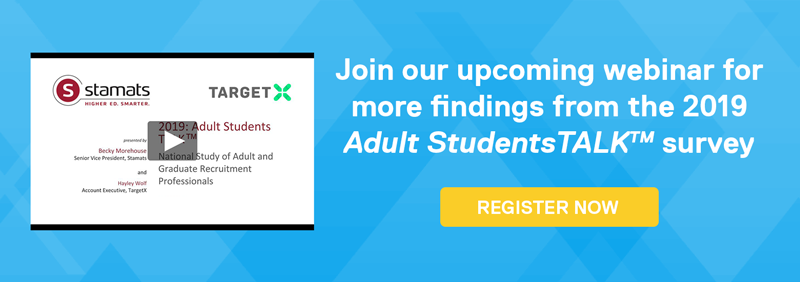Let’s face it — adult and “nontraditional” student populations are becoming more and more important on college campuses today. In fact, according to our recent survey conducted in collaboration with Stamats, 91% of admissions professionals rate adult undergraduate recruitment as “moderately” to “very” important and 96.3% rate graduate student recruitment as “moderately” to “very” important. Based on the findings of this research, there’s definitely room for improvement when it comes to allocating resources and crafting a strategy to better recruit and enroll this unique population.
If you find yourself asking questions like: which institutions are excelling at recruiting adult students and why? How are schools investing resources in recruiting this population more effectively? How does my institution compare? What can I be doing today to make an impact with nontraditional undergrad and/or graduate students?
Then look no further, because the 2019 Adult StudentsTALK™ report findings webinar has answers to all your questions and more. But, if you’re more of a visual person, check out some of the main themes from this year’s survey and key takeaways for higher ed to consider based on real-world insights:

Nontraditional Undergraduate Student Marketing Isn’t Prioritized
From the schools we surveyed, it’s clear that graduate programs are more likely to have a thoughtful, documented communication plan than undergraduate programs targeting adults (73.6% vs 45.5%). Which is an issue in our industry. Adult students have unique needs which require different recruitment strategies and outreach than traditional undergraduate students. And with only half of our surveyed schools having a formally documented recruitment plan for nontraditional students, there’s plenty of room for improvement to better target this essential population of prospective students.
Budget to Support Adult Student Marketing Efforts at the Undergrad Level is M.I.A.
Let’s talk money. The 2019 Adult StudentsTALK™ survey uncovered that 63% of admissions marketers don’t have a dedicated recruitment budget for targeting adult undergrads while 73.6% of their colleagues have specific budget for marketing to adult graduate students. A common theme throughout our research with Stamats was that most community colleges and 4-year public schools lack the budget required to successfully segment and recruit adult undergrads.
Working in higher education, this probably doesn’t come as a surprise to you. But, it’s an opportunity to start thinking about nontraditional students more strategically and allocating dollars accordingly. While we can acknowledge that most schools today are under-resourced and under-staffed, we should also get creative in overcoming these obstacles rather than letting them get in the way or stop our momentum entirely.
It’s Time to Get Smarter About Our Top-of-the-Funnel Lead Gen Strategies
The number one challenge surveyed institutions reported was the ability to generate new prospects. When we dug into this data further, we discovered that 54.7% of graduates are still purchasing lists of prospects, with only 18.9% seeing success in this lead generation tactic. On the flip side, only 24% of professionals responsible for recruiting adult undergrads are buying names (which is more promising!) and only 7.2% report success. It’s time we stop relying on list-buys and start thinking smarter about how to generate leads at the top of the recruitment funnel, given such low success rates compared to other strategies.
Providing Adequate Support Services Is Non-Negotiable For Adult Students
Over 40% of survey respondents reported difficulty in providing adequate support services for adult undergrads, with only 17% hosting virtual information sessions. This is a HUGE missed opportunity — many nontraditional students are working full time and balancing busy schedules, so hosting virtual information sessions allows them to get to know your institution more easily.
That being said, 66% saw success in having admissions staff available for walk-ins outside of standard business hours for both adult undergrad and grad students. When it comes to recruiting adults, we need to consider their hectic schedules and be sure to offer these walk-in hours in the evenings as well for maximum support.

There’s an Expectations vs. Reality Discrepancy in Inquiry Response Times
The one result of the survey we would challenge respondents on is the timeliness in request for information responses. On the one hand, only 16% of admissions staff see responding to inquiries in a timely manner for adult undergrads as a challenge, and only 24.5% see responding to inquiries in a timely manner for grads as a challenge — with majority claiming they respond to inquiries within 48 hours across both areas. While these statistics appear encouraging, Stamats released an Adult StudentsTALK™ research primer where they secret-shopped eight different schools known for their success in recruiting and enrolling adult students on timeliness and turnaround. They found that 5 out of 8 total secret shopper tests conducted—did not follow up on the inquiry form submitted within 48 hours beyond an automated email confirmation that the request for information was received.
And to set the record straight, an automated email saying that you received a student’s inquiry is not a real response. Examining this practice further, our 2017 Social Admissions Report found that 53% of students expect a response within 24 hours of contacting a college admissions representative. However, our 2018 Social Admissions Report revealed that nearly half of the students surveyed have lowered their expectations to receiving a response from admissions offices from 24 hours to within a week. Students shouldn’t have to lower their expectations regarding outreach from an institution — instead we should leverage this data to push us to be better at following up!
Your School’s Website is More Important Than Your Social Media Presence
The 2019 Adult StudentsTALK™ survey results showed that Facebook and other social media advertising is viewed as successful by 48.5% of admissions staff responsible for adult undergrad recruitment and 60.4% responsible for graduate student recruitment. However, we know from the 2018 Social Admissions Report data that social media is rated among the least trusted sources of college information by students — less than 4% of undergraduate students rated social media as most trustworthy and less than half of students follow or like a college page directly.
Instead, 30% of students surveyed for the Social Admissions Report ranked a college’s website as the most trustworthy source of information during their college search process. This is good news, as 71.1% of adult undergrad and 73.6% (the highest percentages in this portion of the study) see their college website as the most successful recruitment tactic for adult prospects. This means you should spend more of your digital marketing resources on your website, rather than investing precious time and effort on perfecting your social media channels for an untrusting audience.
What You Need to Know:
2019 Adult StudentsTALK™ Key Takeaways and Next Steps
Nontraditional students who apply for undergraduate or graduate admissions are extremely likely to enroll, and typically have a condensed timeline to do so. Here are the most important areas to keep in mind and best practices on recruiting and engaging this unique population:
1. Respond quickly to inquiries and make information accessible on your website.
This can mean creating high-level FAQ pages, implementing live chat features, and leveraging automated communications for enhanced turnaround times. Nontraditional students, in particular, operate on an accelerated application to enrollment timeline and are often applying to less schools than traditional prospects.
2. Consider the lifestyle of a typical nontraditional student and eliminate barriers for them to engage with your institution.
It’s important to keep in mind the hectic schedules most adult learners are balancing on a daily basis, so hosting events, webinars, and even appointments beyond the 8am – 5pm window is important. Utilizing mobile-first technology is equally as important, since this population is known to engage with your school from their mobile device first. This means that having an online application designed with nontraditional students in mind and can be completed entirely from a smartphone will move the needle for conversions.
3. A multi-channeled marketing approach is a must to communicate with this target population of prospective students.
When it comes to nontraditional students, the standard age range is pretty robust, meaning there are multiple generations within the same student type. Leveraging a combination of print, email, texting, and digital media strategies is crucial in meeting each student’s unique needs and communication preferences. Plus, this population averages three months or less from the point of application to matriculation, so personalizing multi-channel communications with automation in place is key to navigating such a condensed cycle of recruiting adult undergraduates.

